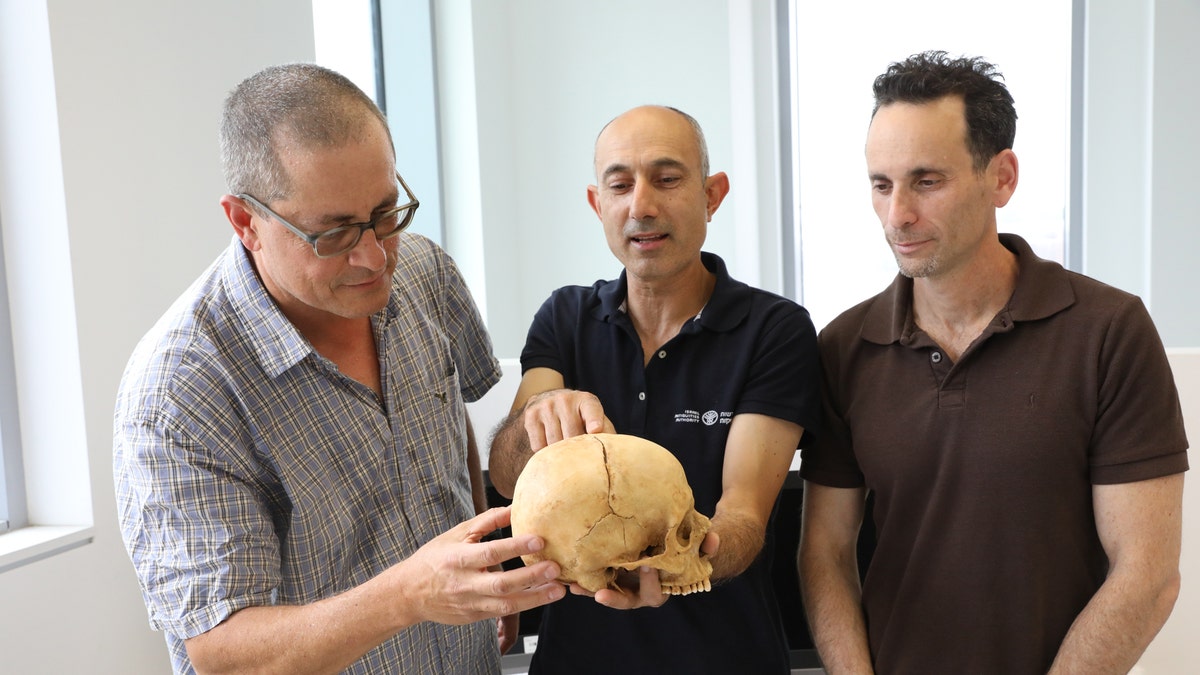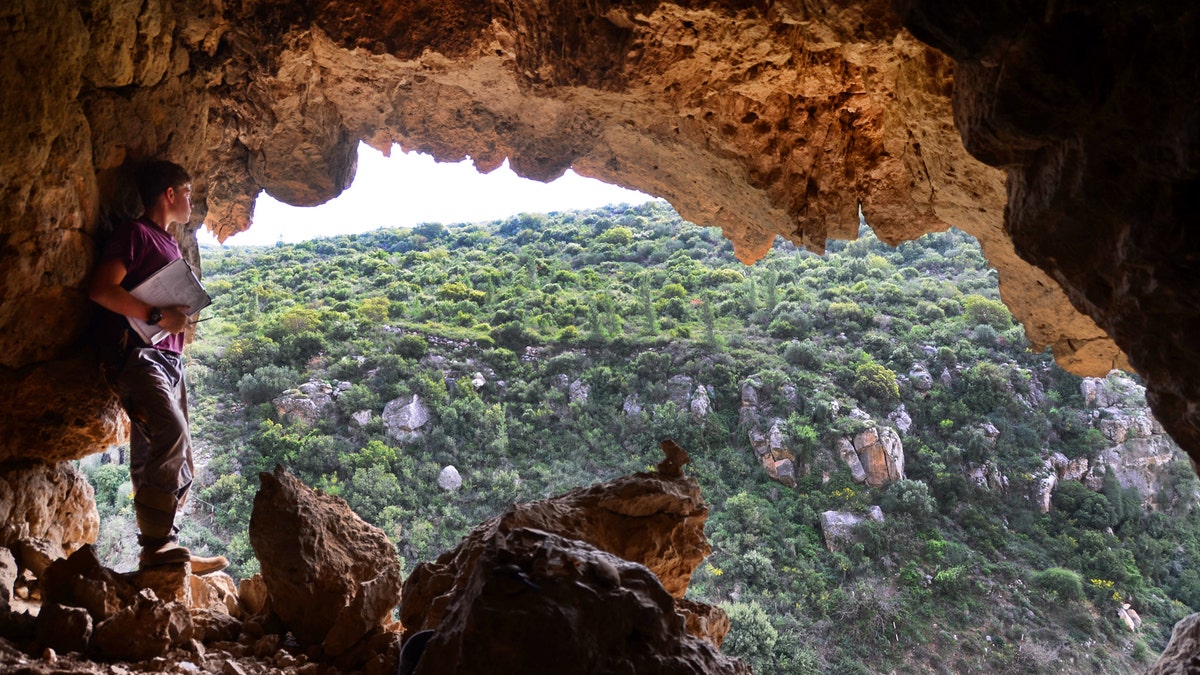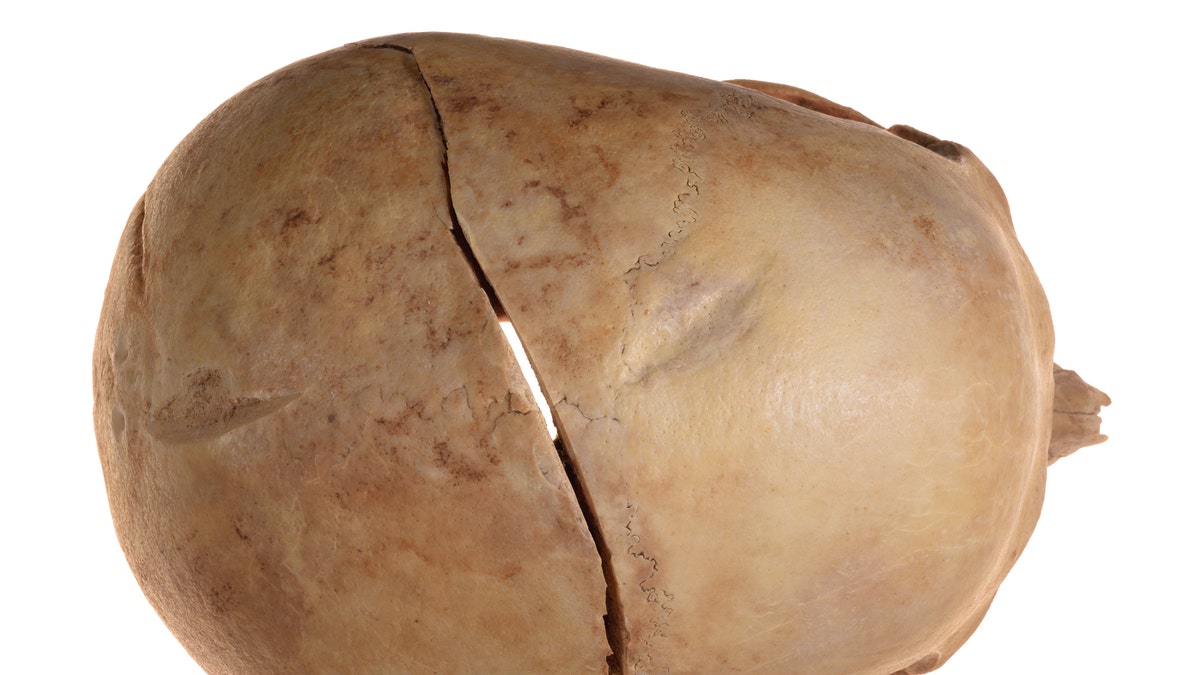
Left to right: Prof. Boaz Zissu of Bar-Ilan University, Dr. Yossi Nagar of the Israel Antiquities Authority and Dr. Haim Cohen of the National Center for Forensic Medicine and Tel Aviv University with the skull (Israel Antiquities Authority)
Experts in Israel have found the earliest evidence of ancient “blood vengeance” in a cave in the Jerusalem Hills.
A human skull and palm bones were found in the cave by Boaz Zissu, an archaeology professor at Israel’s Bar-Ilan University. The remains have been dated to sometime from the 10th century to 11th century A.D.
Experts from the Israel Antiquities Authority and Tel Aviv University identified the bones as belonging to a man aged between 25 and 40 years.
DEAD SEA SCROLLS DISCOVERY: TECH REVEALS HIDDEN SCRIPT
"The skull cap shows signs of two traumatic injuries that eventually healed -- evidence of previous violence experienced by the victim -- as well as a small cut-mark caused close to the time of death, and a blow by a sword that caused certain and immediate death,” the researchers said, in a statement.

The cave where the skull was found. (Credit, Prof. Boaz Zissu, Bar-Ilan University)
An examination of the skull revealed a great resemblance to the local Bedouin population, which apparently had a tradition of blood vengeance, even before the birth of Islam, according to the experts.
Archaeologists cited a text from the beginning of the 20th century that tells the story of a case of revenge, during which the murderer presented his family with the skull and right hand of the victim by way of proof. “These are precisely the parts of the body that were discovered in the present case,” they said. “Since this is a person who was previously involved in violent incidents who then died from the fatal blow, the researchers say it concluded that the earliest evidence of blood vengeance has been discovered.”
TROVE OF ANCIENT 'FREEDOM COINS' UNEARTHED IN JERUSALEM
The findings are being presented this week at the 44th Archaeological Congress at Ben-Gurion University of the Negev.

The cracks in the skull. (Credit: Clara Amit, Israel Antiquities Authority)
The remains are the latest fascinating find in Israel. These include the recent unearthing of a trove of bronze coins in Jerusalem. In February, archaeologists announced the discovery of a clay seal mark that may bear the signature of the Biblical Prophet Isaiah.
Also in February, experts revealed that they had uncovered a rare multicolored Roman mosaic featuring three toga-wearing figures during excavations in the ancient city of Caesarea.
ANCIENT INSCRIPTION UNEARTHED IN JERUSALEM, THRILLING ARCHAEOLOGISTS
In January, archaeologists announced the discovery of a large 1,500-year-old pool and elaborate fountain at the site of an ancient church near Jerusalem.
Last November, new evidence dated Christ’s tomb in Jerusalem’s Church of the Holy Sepulchre to the Roman era, matching historical records.
Archaeologists also uncovered a stunning 1,500-year-old Christian mosaic in the ancient Mediterranean coastal city of Ashdod-Yam, now part of the modern city of Ashdod.
LOST ROMAN CITY THAT WAS HOME TO JESUS' APOSTLES FOUND, SAY ARCHAEOLOGISTS
Other finds include the skeleton of a pregnant woman, dating back 3,200 years, in Israel’s Timna Valley, at a place once called King Solomon’s Mines.
In October 2017, archaeologists in Jerusalem announced that they have uncovered a new section of the Western Wall that has been hidden for 1,700 years.
Also in 2017, an ancient Greek inscription was found on a 1,500-year-old mosaic floor near the Damascus Gate in the Old City of Jerusalem.
Some experts also believe they have found the lost Roman city of Julias, formerly the village of Bethsaida, which was the home of Jesus' apostles Peter, Andrew and Philip.
Follow James Rogers on Twitter @jamesjrogers
